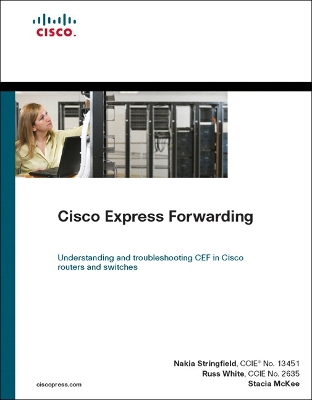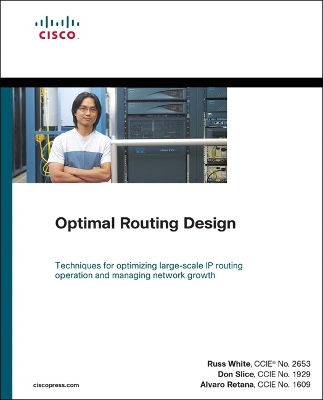Networking Technology
3 total works
Cisco Express Forwarding
Understanding and troubleshooting CEF in Cisco routers and switches
Nakia Stringfield, CCIE® No. 13451/Russ White, CCIE No. 2635/Stacia McKee
How does a router switch a packet? What is the difference between routing a packet, switching a frame, and packet switching? What is the Cisco® Express Forwarding (CEF) feature referred to in Cisco documentation and commonly found in Cisco IOS® commands? CEF is a general term that describes the mechanism by which Cisco routers and Catalyst® switches packet-switch (route) frames. CEF is found in almost all Cisco routers and Catalyst switches, and understanding how CEF operates can improve the performance, scalability, and efficiency of your network.
Cisco Express Forwarding demystifies the internal workings of Cisco routers and switches, making it easier for you to optimize performance and troubleshoot issues that arise in Cisco network environments. This book addresses common misconceptions about CEF and packet switching across various platforms, helping you to improve your troubleshooting skills for CEF- and non-CEF-related problems.
The first part of the book provides an overview of packet-switching architectures and CEF operation and advanced features. It also covers the enhanced CEF structure and general troubleshooting. The second part of the book provides case studies that focus on the common topics that have been problematic for customers and those supporting Cisco networks.
Full of practical examples and configurations, this book draws on years of experience to help you keep your Cisco networks running efficiently.
- Learn the key features of packet-switching architectures
- Understand the basics of the CEF architecture and operation
- Examine the enhanced CEF structure, which improves scalability
- Learn how to troubleshoot in software-switching environments
- Understand the effect of CEF on a Cisco Catalyst 6500 Supervisor 720
- Configure and troubleshoot load sharing with CEF
- Evaluate the effect of CEF in an MPLS VPN environment
- Review CEF design considerations that impact scalability
This book is part of the Networking Technology Series from Cisco Press®, which offers networking professionals valuable information for constructing efficient networks, understanding new technologies, and building successful careers.
Category: Networking
Covers: Routing and Switching
Techniques for optimizing large-scale IP routing operation and managing network growth
- Understand the goals of scalable network design, including tradeoffs between network scaling, convergence speed, and resiliency
- Learn basic techniques applicable to any network design, including hierarchy, addressing, summarization, and information hiding
- Examine the deployment and operation of EIGRP, OSPF, and IS-IS protocols on large-scale networks
- Understand when and how to use a BGP core in a large-scale network and how to use BGP to connect to external networks
- Apply high availability and fast convergence to achieve 99.999 percent, or “five 9s” network uptime
- Secure routing systems with the latest routing protocol security best practices
- Understand the various techniques used for carrying routing information through a VPN
Optimal Routing Design provides the tools and techniques, learned through years of experience with network design and deployment, to build a large-scale or scalable IP-routed network. The book takes an easy-to-read approach that is accessible to novice network designers while presenting invaluable, hard-to-find insight that appeals to more advanced-level professionals as well.
Written by experts in the design and deployment of routing protocols, Optimal Routing Design leverages the authors’ extensive experience with thousands of customer cases and network designs. Boiling down years of experience into best practices for building scalable networks, this book presents valuable information on the most common problems network operators face when seeking to turn best effort IP networks into networks that can support Public Switched Telephone Network (PSTN)-type availability and reliability.
Beginning with an overview of design fundamentals, the authors discuss the tradeoffs between various competing points of network design, the concepts of hierarchical network design, redistribution, and addressing and summarization. This first part provides specific techniques, usable in all routing protocols, to work around real-world problems. The next part of the book details specific information on deploying each interior gateway protocol (IGP)—including EIGRP, OSPF, and IS-IS—in real-world network environments. Part III covers advanced topics in network design, including border gateway protocol (BGP), high-availability, routing protocol security, and virtual private networks (VPN). Appendixes cover the fundamentals of each routing protocol discussed in the book; include a checklist of questions and design goals that provides network engineers with a useful tool when evaluating a network design; and compare routing protocols strengths and weaknesses to help you decide when to choose one protocol over another or when to switch between protocols.
“The complexity associated with overlaying voice and video onto an IP network involves thinking through latency, jitter, availability, and recovery issues. This text offers keen insights into the fundamentals of network architecture for these converged environments.”
—John Cavanaugh, Distinguished Services Engineer, Cisco Systems®
This book is part of the Networking Technology Series from Cisco Press‚ which offers networking professionals valuable information for constructing efficient networks, understanding new technologies, and building successful careers.
The Art of Network Architecture
Business-Driven Design
The business-centered, business-driven guide to architecting and evolving networks
The Art of Network Architecture is the first book that places business needs and capabilities at the center of the process of architecting and evolving networks. Two leading enterprise network architects help you craft solutions that are fully aligned with business strategy, smoothly accommodate change, and maximize future flexibility.
Russ White and Denise Donohue guide network designers in asking and answering the crucial questions that lead to elegant, high-value solutions. Carefully blending business and technical concerns, they show how to optimize all network interactions involving flow, time, and people.
The authors review important links between business requirements and network design, helping you capture the information you need to design effectively. They introduce today’s most useful models and frameworks, fully addressing modularity, resilience, security, and management. Next, they drill down into network structure and topology, covering virtualization, overlays, modern routing choices, and highly complex network environments.
In the final section, the authors integrate all these ideas to consider four realistic design challenges: user mobility, cloud services, Software Defined Networking (SDN), and today’s radically new data center environments.
• Understand how your choices of technologies and design paradigms will impact your business
• Customize designs to improve workflows, support BYOD, and ensure business continuity
• Use modularity, simplicity, and network management to prepare for rapid change
• Build resilience by addressing human factors and redundancy
• Design for security, hardening networks without making them brittle
• Minimize network management pain, and maximize gain
• Compare topologies and their tradeoffs
• Consider the implications of network virtualization, and walk through an MPLS-based L3VPN example
• Choose routing protocols in the context of business and IT requirements
• Maximize mobility via ILNP, LISP, Mobile IP, host routing, MANET, and/or DDNS
• Learn about the challenges of removing and changing services hosted in cloud environments
• Understand the opportunities and risks presented by SDNs
• Effectively design data center control planes and topologies


